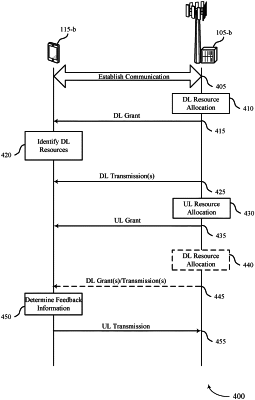| CPC H04W 72/23 (2023.01) [H04L 1/1664 (2013.01); H04L 1/1861 (2013.01); H04L 5/0057 (2013.01); H04L 5/0091 (2013.01); H04W 72/21 (2023.01); H04L 5/0055 (2013.01)] | 10 Claims |

|
1. A method for wireless communication performed by a user equipment (UE), comprising:
receiving, from a network entity, one or more downlink grants scheduling a set of downlink transmissions;
receiving, from the network entity, a single uplink grant that schedules uplink resources for a physical uplink shared channel (PUSCH) to be transmitted by the UE to the network entity, the uplink grant comprising a field indicating a number of downlink transmissions for which the UE is to transmit feedback information in the PUSCH
receiving, from the network entity, a subsequent downlink grant after receiving the single uplink grant, the subsequent downlink grant scheduling another downlink transmission that is not in the set of downlink transmissions and that has a higher priority than the set of downlink transmissions, the scheduled uplink resources for the PUSCH not including uplink resources for the other downlink transmission;
receiving, from the network entity, a plurality of downlink transmissions including one or more of the set of downlink transmissions and including the other downlink transmission;
generating the feedback information based on the reception of the plurality of downlink transmissions, the feedback information including:
a first indication, for each received downlink transmission of the plurality of downlink transmissions, of whether the downlink transmission was successfully received or unsuccessfully received, and
based on the number of downlink transmissions for which the UE is to transmit feedback information in the PUSCH being greater than the number of received downlink transmissions in the plurality of downlink transmissions, a second indication, for each of one or more missed downlink transmissions of the set of downlink transmissions, that the downlink transmission was not received;
rate-matching uplink data around the feedback information in the PUSCH based on the indication of the number of downlink transmissions for which the UE is to transmit feedback information; and
transmitting the PUSCH to the network entity.
|